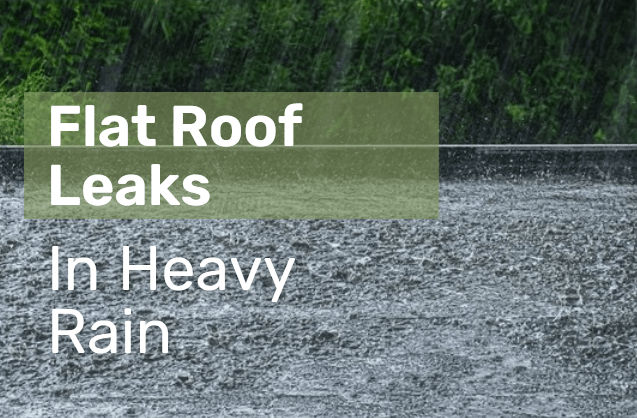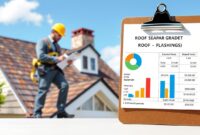Flat roof leaks in roofing systems are more common than in other types of roofs due to several factors. It is because flat roofs lack the natural slope that allows water to drain off quickly, unlike pitched roofs. This design flaw makes them more prone to pooled water, significantly increasing the risk of leaks.
That’s why heavy rain can be a nightmare for flat roofs, leading to frustrating leaks that can disrupt your life and cause damage to your property. This article will dive into the common causes of flat roof leaks and provide practical solutions.
What Are the Causes of Flat Roof Leaks in Heavy Rain?
Understanding the common causes can help you address and prevent flat roof leaks in your home. Here are five leading causes of flat roof leaks:

● Plumbing Problems
Improperly installed or worn vent pipe flashing can allow water to penetrate the roof. Additionally, leaks can occur through ventilation fan ducts. Conducting a thorough roof inspection and replacing these components if necessary, especially in a commercial building, is crucial.
● Natural Damage
Heavy storms with high winds can cause natural damage on flat roofs, necessitating inspection and repairs by a professional roofer. Falling branches or trees can cause structural damage, allowing water to enter during rainfall.
Read also: Flat Roof with Peel and Stick Roofing for Elegant Houses
● Corrosion
Flat metal roofs, famous for their durability, can develop corrosion if not properly maintained. Corrosion around fasteners or significant damage can result in leaks during heavy rain.
● Skylights
While skylights provide natural lighting, improper installation can lead to water seepage during heavy rainstorms. That’s why skylights are usually installed and sealed to prevent damage.
● Old Shingles
Flat roofs, especially those with asphalt shingles, can develop leaks when the shingles or the roof deck beneath them wear out or become damaged. Moreover, exposure to the elements, such as sunlight and rain, can cause shingles to deteriorate over time, leading to cracks, curling, or missing pieces.
Are Flat Roof Leaks Common?
Flat roof leaks are relatively common compared to other roof types, primarily due to their unique design and structure. Flat roofs lack the natural incline of pitched roofs, complicating water drainage and increasing the likelihood of water damage.
This increases the risk of water pooling and accumulating on the roof, leading to leaks over time. Additionally, flat roofs are more exposed to the elements, including harsh weather conditions like heavy rain and snow.
Exposure to elements and temperature changes can deteriorate roofing materials faster, leading to leaks. Also, flat roof construction is complex and needs proper sealing and waterproofing, which requires careful installation and maintenance.
How Do You Fix a Leaking Roof On a Flat Roof?
Fixing a leaking roof on a flat roof requires a systematic approach to identify and address the underlying issue. Here are some flat roof repair tips to prevent leaks:
● Locate the Source
Check the roof to find where the leak is. Check for visible damage, like cracks, gaps, or missing materials. Please pay attention to vents, skylights, and seams, as they are common trouble spots.
● Clear Debris
Remove debris, leaves, or dirt from the roof surface and the gutters. Clogged gutters can prevent proper water drainage, exacerbating leaks.
● Repair or Replace Damaged Materials
Depending on the damage, you might have to fix or change the roof materials. Fix damaged shingles, seals, or membranes quickly. Use recommended materials for flat roofs to waterproof properly.
Read also: Installing a Flat Roof Membrane
● Apply Sealant
Use suitable roofing sealant on leak-prone areas like seams, flashing, and vents. Ensure the sealant works with your roof and follow the manufacturer’s instructions.
● Enhance Drainage
Enhancing the roof’s drainage system is crucial to prevent roof leaks and reduce the risk of water damage. Adding more gutters, downspouts, or scuppers can significantly improve water flow and efficiently redirect it away from the building.
● Professional Help
It is advisable to seek assistance from a professional roofing service for significant or complex leaks. These experts can detect hidden leaks and provide a more comprehensive assessment to address any underlying issues that could precipitate future problems.
Read also: What is the Best Elastomeric Roof Coating for Flat Roof?
While a temporary fix for a leaking flat roof is feasible, taking preventive measures through regular maintenance remains the best strategy against flat roof leaks in heavy rain. Scheduling regular inspections can help catch potential issues before they necessitate roof replacing.


